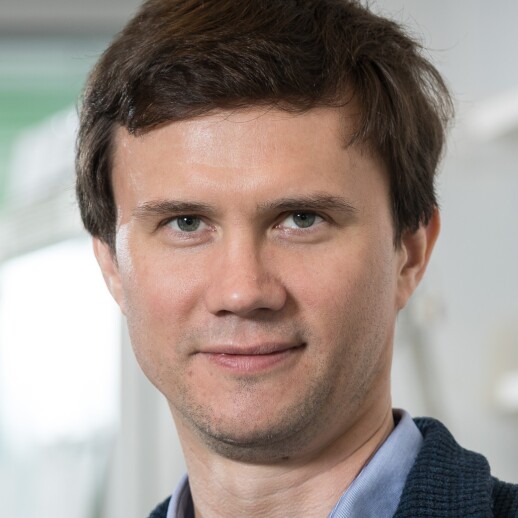RNA polymerase and Mechanism of Transcription
RNA polymerase is the enzyme that carries out the first step in gene expression, synthesis of RNA. We study several classes of RNA polymerases with the aim of understanding the fundamental aspects of transcription regulation, catalytic mechanism, and developing medically relevant transcription inhibitors.
The properties of a cell are determined by the information encoded in its genome. Understanding how such information is differentially and dynamically retrieved in response to environmental changes and cellular needs is a major challenge facing molecular biology. The focal point of our research is a multisubunit RNA polymerase (RNAP), the enzyme that carries out the first step in gene expression, synthesis of RNA. Bacterial RNAP, a five-subunit complex (ααββ’ω), represents the simplest model system for studying the fundamental mechanistic properties of all multisubunit RNAPs and is a validated target for antibacterial drugs.
The mechanisms of chemical catalysis and movement. RNAP is one of nature's most processive enzymes capable of synthesizing RNAs tens of thousands nucleotides long without ever releasing the transcript. RNAP functions as a molecular motor and a helicase; its movement is ultimately powered by the free energy liberated as nucleoside triphosphates are condensed into the nascent RNA and pyrophosphate is released. Our laboratory features an extensive repertoire of state-of-the-art biophysical and biochemical methods that allow monitoring of the individual steps in transcription cycle in real time. We use this framework to study the fundamental aspect of transcription and the mechanism of action of transcription inhibitors.
Transcription systems of medically relevant non-model bacteria. Expression of the majority of genes is regulated at the stage of transcription. Bacterial RNAP associates with many regulatory factors at all stages of transcription. Some transcription factors are universally conserved in Bacteria yet their functionalities in different bacterial lineages are not identical. Other transcription factors are restricted to subsets of Bacteria and many bacterial lineages contain unique transcription factors with poorly understood functionalities. We study transcription systems of medically relevant non-model bacteria to broaden our understanding of the mechanism and regulation of bacterial transcription and to characterize the regulatory strategies involved in virulence.
Substrate selection by different classes of RNA polymerases and substrate analogue inhibitors. The laboratory has established analysis methods for potential targets (bacterial RNAPs and viral RNA-dependent RNA polymerases) and off-targets (eukaryotic nuclear and mitochondrial RNAPs) of transcriptional inhibitors. We utilize this framework to study the substrate selection mechanisms and the selectivity of substrate analogue inhibitors of transcription. All classes of RNA polymerases select ribonucleoside triphosphate substrates (NTPs) based on the Watson-Crick base pairing to the template nucleic acids. However, base pairing energy constitutes only a small fraction of the total binding energy and a proper recognition of the ribose and the triphosphate moieties is critical for the fidelity of the RNA synthesis. Different structural classes of RNA polymerases use different strategies to recognise the ribose and triphosphate moieties of the substrate NTP. The detailed understanding of the substrate selection process is a fundamentally important question in enzymology and has direct implications for concept based design of transcription inhibitors.
Mäkinen J.J., Shin Y., Vieras E., Virta P., Metsä-Ketelä M., Murakami K.S., Belogurov G.A. (2021) The mechanism of the nucleo-sugar selection by multi-subunit RNA polymerases. Nat. Commun. 12:796.
Said N., Hilal T., Sunday N.D., Khatri A, Bürger J., Mielke T., Belogurov G.A., Loll B., Sen R., Artsimovitch I., Wahl M.C. (2021) Steps toward translocation-independent RNA polymerase inactivation by terminator ATPase Rho. Science 371(6524):eabd1673.
Pei H.-H., Hilal T., Chen Z.A., Huang Y.-H., Gao Y., Said N., Loll B., Rappsilber J., Belogurov G.A., Artsimovitch I., Wahl M.C. (2020) The delta subunit and NTPase HelD institute a two-pronged mechanism for RNA polymerase recycling. Nat. Commun. 11(1):6418.
Agapov A., Ignatov A., Turtola M., Belogurov G., Esyunina D., Kulbachinskiy A. (2020) Role of the trigger loop in translesion RNA synthesis by bacterial RNA polymerase. J. Biol. Chem. 295(28):9583-9595.
Prajapati R.K., Rosenqvist P., Palmu K., Mäkinen J.J., Malinen A.M., Virta P., Metsä-Ketelä M., Belogurov G.A. (2019) Oxazinomycin arrests RNA polymerase at the polythymidine sequences. Nucleic Acids Res. 47(19):10296-10312.
Belogurov G.A., Artsimovitch I. (2019) The mechanisms of substrate selection, catalysis and translocation by the elongating RNA polymerase. J. Mol. Biol. 431(20):3975-4006.
Turtola M., Mäkinen J.J., Belogurov G.A. (2018) Active site closure stabilizes the backtracked state of RNA polymerase. Nucleic Acids Res. 46(20):10870-10887.
Sanz-Murillo M., Xu J., Belogurov G.A., Calvo O., Gil-Carton D., Moreno-Morcillo M., Wang D., Fernández-Tornero C. (2018) Structural basis of RNA polymerase I stalling at UV light-induced DNA damage. Proc. Natl. Acad. Sci. USA 115(36):8972-8977.
Nedialkov Y., Svetlov D., Belogurov G.A., Artsimovitch I. (2018) Locking the non-template DNA to control transcription. Mol. Microbiol. 109(4):445-457.
Artsimovitch I., Belogurov G.A. (2018) Uneven braking spins RNA polymerase into a pause. Mol. Cell 69(5):723-725.
NandyMazumdar M., Nedialkov Y., Svetlov D., Sevostyanova A., Belogurov G.A., Artsimovitch I. (2016) RNA polymerase gate loop guides the nontemplate DNA strand in transcription complexes. Proc. Natl. Acad. Sci. USA 113(52):14994-14999.
Turtola M., Belogurov G.A., (2016) NusG inhibits RNA polymerase backtracking by stabilizing the minimal transcription bubble. eLife 5. pii: e18096.
Maddalena L.L., Niederholtmeyer H., Turtola M., Swank Z.N., Belogurov G.A., Maerkl S.J. (2016) GreA and GreB enhance expression of Escherichia coli RNA polymerase promoters in a reconstituted transcription-translation system. ACS Synth. Biol. 5(9):929-35.
Esyunina D., Turtola M., Pupov D., Bass I., Klimaðauskas S., Belogurov G., Kulbachinskiy A. (2016) Lineage-specific variations in the trigger loop modulate RNA proofreading by bacterial RNA polymerases. Nucleic Acids Res. 44(3):1298-308.
Belogurov G.A., Artsimovitch I. (2015) Regulation of transcript elongation. Annu. Rev. Microbiol. 69: 49-69.
Artsimovitch I., Belogurov G.A. (2015) Creative math of RNA polymerase III termination: sense plus antisense makes more sense. Mol. Cell 58(6):974-6.
Malinen A.M., Turtola M., Belogurov G.A. (2015) Monitoring translocation of multisubunit RNA polymerase along the DNA with fluorescent base analogues. Methods Mol. Biol. 1276:31-51.
Malinen A.M., NandyMazumdar M., Turtola M., Malmi H., Grocholski T., Artsimovitch I., Belogurov G.A. (2014) CBR antimicrobials alter coupling between the bridge helix and the ß subunit in RNA polymerase. Nat. Commun. 5:3408.
Malinen A.M., Turtola M., Parthiban M., Vainonen L., Johnson M.S., Belogurov G.A. (2012) Active site opening and closure control translocation of multisubunit RNA polymerase. Nucleic Acids Res. 40(15): 7442-51.
Solving the Ancient Problem of Nucleic Acid Synthesis Gives Clues for the Design of New Antiviral Drugs. Featured in: Phys.org, EurekAlert!, ScienMag.


